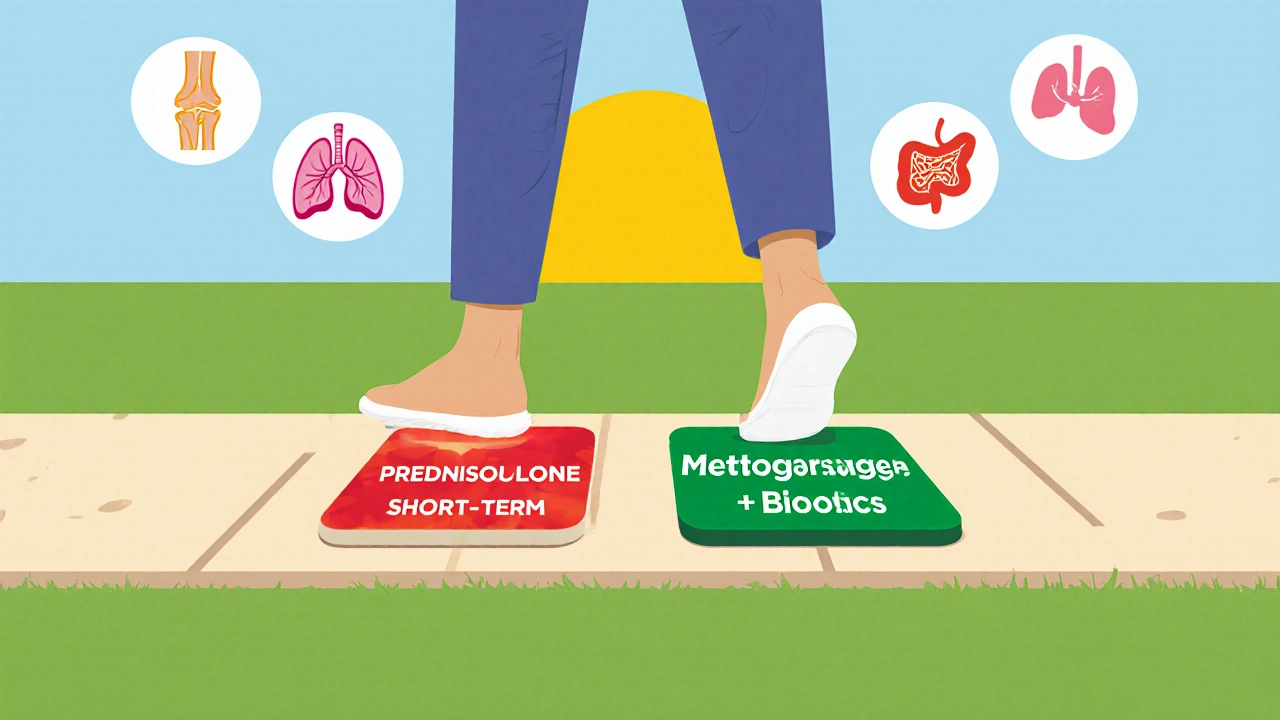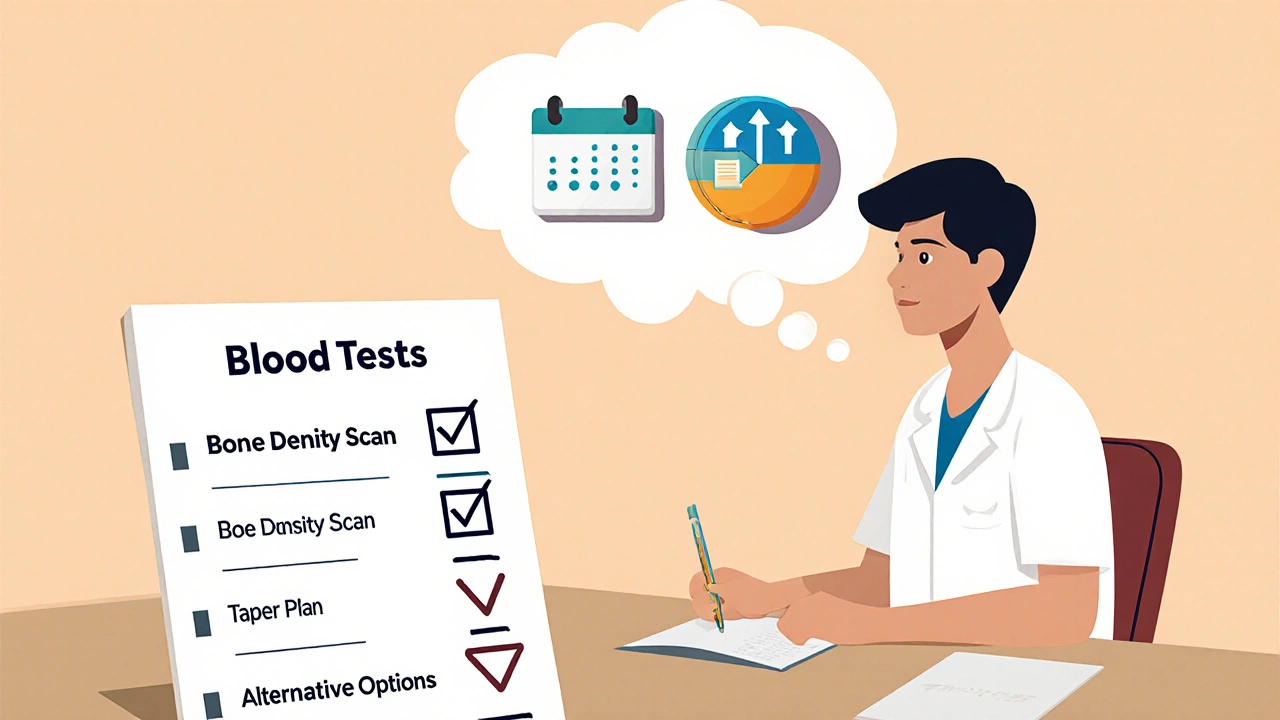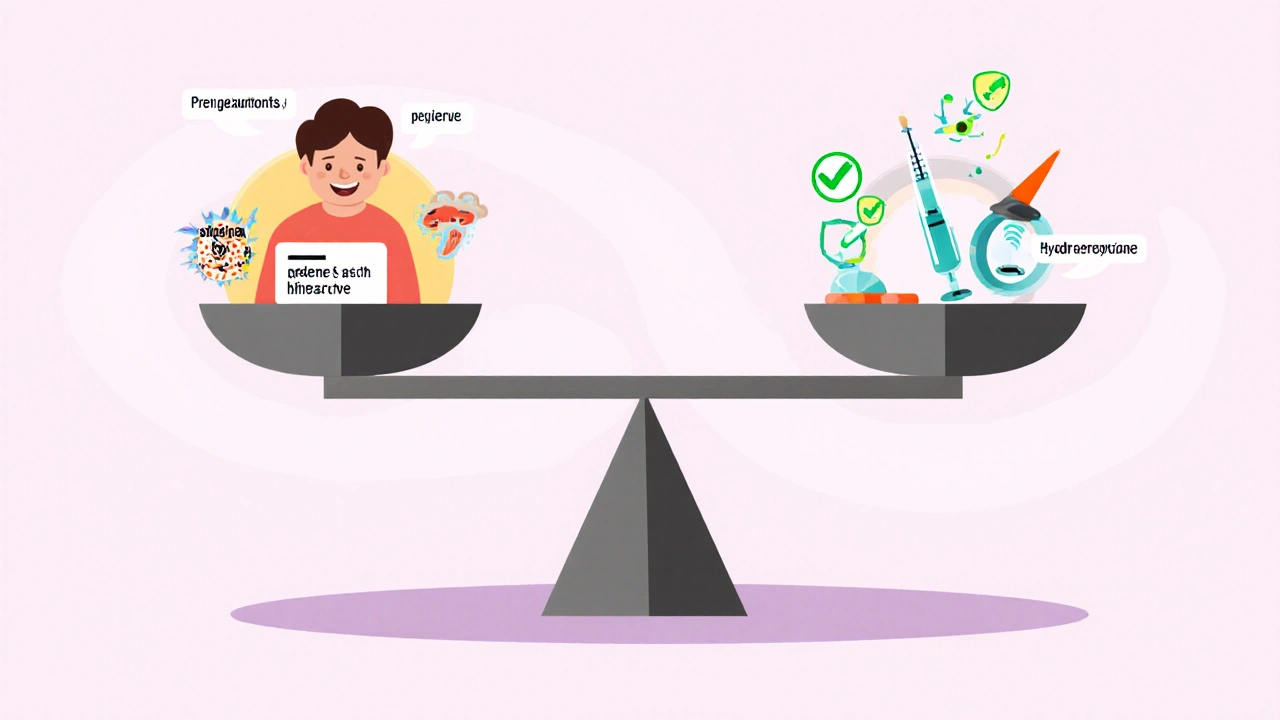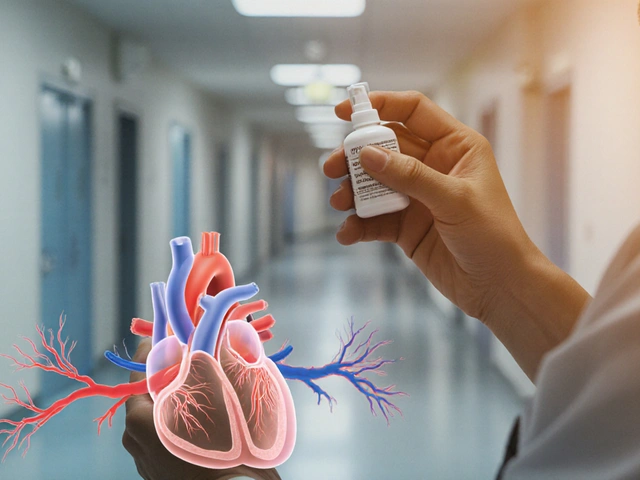When your body’s immune system goes into overdrive-whether from arthritis, asthma, or an autoimmune flare-doctors often reach for Prednisolone. It’s fast, powerful, and for many, life-changing. But it’s not the only option. And if you’ve been on it for more than a few weeks, you’ve probably felt the weight of its side effects: weight gain, mood swings, trouble sleeping, or even bone thinning. That’s why so many people start asking: Prednisolone alternatives exist-but which ones actually work without the same toll?
What Prednisolone Does (and Why It’s Still Used)
Prednisolone is a synthetic corticosteroid. It mimics cortisol, your body’s natural stress hormone, and shuts down inflammation at the source. It’s used for conditions like rheumatoid arthritis, lupus, ulcerative colitis, severe allergies, and even some types of leukemia. In acute flare-ups, nothing works faster. A single dose can reduce swelling in your joints or open up your airways within hours.
But here’s the catch: it doesn’t just calm inflammation. It suppresses your entire immune system. That’s why long-term use increases your risk of infections, cataracts, high blood pressure, and osteoporosis. A 2023 study in The Lancet Rheumatology found that people taking Prednisolone daily for over six months had a 40% higher chance of breaking a bone compared to those not on steroids. That’s not a small risk.
Top Alternatives to Prednisolone
Doctors now have more tools than ever to manage inflammation without relying on high-dose steroids. Here are the most common alternatives, backed by clinical data and real-world use.
1. Methotrexate
Methotrexate isn’t a steroid. It’s a disease-modifying antirheumatic drug (DMARD). Originally developed as a cancer treatment, it’s now one of the most prescribed drugs for autoimmune diseases like rheumatoid arthritis and psoriasis. Unlike Prednisolone, it doesn’t just mask symptoms-it slows disease progression.
It takes weeks to kick in. Most people feel improvement after 6-8 weeks. But once it does, the results are lasting. Many patients can reduce or even stop Prednisolone entirely after starting methotrexate. Side effects? Nausea, fatigue, and a small risk of liver stress. But these are manageable with folic acid supplements and regular blood tests.
2. Hydroxychloroquine
Once known mostly as a malaria drug, hydroxychloroquine is now a go-to for lupus and some forms of rheumatoid arthritis. It’s mild compared to Prednisolone, but it’s also much safer for long-term use. It doesn’t cause weight gain, bone loss, or blood sugar spikes.
Studies show it reduces flare frequency by up to 50% in lupus patients. The main concern? Eye toxicity-but that’s rare if you get an annual eye exam. For people who need daily control without the steroid crash, it’s a solid choice.
3. Biologics: Adalimumab, Etanercept, and Others
Biologics are targeted therapies. Instead of blanket-immune suppression like Prednisolone, they block specific proteins-like TNF-alpha-that trigger inflammation. Adalimumab (Humira) and etanercept (Enbrel) are two of the most common.
They’re expensive-often over $5,000 a month without insurance-but they work wonders for people who haven’t responded to other treatments. Many patients go from being housebound to hiking again. Side effects include injection-site reactions and a slightly higher risk of serious infections like tuberculosis. Screening is required before starting.
4. Azathioprine and Mycophenolate
These are older immunosuppressants, often used in autoimmune conditions like vasculitis or inflammatory bowel disease. They’re not fast-acting, but they’re reliable for long-term control. Azathioprine has been used since the 1960s and is still common in transplant and autoimmune care.
They require regular blood monitoring because they can lower white blood cell counts. But compared to Prednisolone, they don’t cause mood swings or facial swelling. For patients needing steady, low-level suppression, they’re a quiet but effective option.
5. Non-Steroidal Anti-Inflammatories (NSAIDs)
Drugs like ibuprofen, naproxen, and celecoxib are the first line for mild inflammation. They’re great for occasional joint pain or headaches. But they don’t touch the root cause of autoimmune disease. If your condition is moderate to severe, NSAIDs alone won’t cut it.
Long-term use carries risks: stomach ulcers, kidney damage, and increased heart attack risk. They’re not a replacement for Prednisolone in serious cases-but they can help reduce the dose you need.
Prednisolone vs Prednisone: What’s the Difference?
You’ll often hear these two names used interchangeably. But there’s a key difference. Prednisone is an inactive prodrug. Your liver has to convert it into Prednisolone before it works. Prednisolone is already active.
For most people, this doesn’t matter. But if you have liver disease-like cirrhosis or severe hepatitis-your body may not convert Prednisone properly. In those cases, Prednisolone is the only option. In Australia, Prednisolone is more commonly prescribed for this reason.

When to Consider Switching
You don’t need to switch just because you’re on Prednisolone. But if you’ve been taking it for more than three months, or if you’re on more than 7.5 mg per day, it’s time to talk about alternatives. The goal isn’t always to stop it completely-it’s to use the lowest dose for the shortest time possible.
Signs you should discuss alternatives:
- Weight gain around your midsection or face
- Difficulty sleeping or mood changes
- Bone pain or fractures
- High blood pressure or blood sugar spikes
- Getting sick more often than usual
These aren’t normal side effects-they’re warning signs your body is under too much stress from the drug.
What Doesn’t Work (And Why)
There’s a lot of misinformation out there. Some people try turmeric, CBD oil, or special diets to replace Prednisolone. While these may help with mild symptoms, they don’t stop autoimmune damage. A 2024 review in Arthritis Care & Research found no evidence that supplements can replace corticosteroids in moderate to severe cases.
Don’t stop Prednisolone cold turkey. That can trigger adrenal crisis-a life-threatening drop in cortisol. Always taper under medical supervision.

Real-World Choice: What Patients Actually Pick
In a 2024 survey of 1,200 Australian patients with autoimmune conditions:
- 48% switched to methotrexate as their first alternative
- 22% moved to biologics after failing other options
- 18% used hydroxychloroquine for lupus or mild arthritis
- 12% stayed on low-dose Prednisolone with a DMARD for backup
The most successful patients combined treatments. For example: low-dose Prednisolone (5 mg/day) with methotrexate. That gave them control without the worst side effects.
Final Thoughts: It’s Not About Finding the Perfect Drug
There’s no one-size-fits-all solution. The right alternative depends on your condition, your age, your other health issues, and your tolerance for side effects. Some people need biologics. Others do fine with methotrexate. A few can manage with hydroxychloroquine and lifestyle changes.
The key is to stop seeing Prednisolone as the only answer-and start seeing it as a bridge. Your goal isn’t to avoid all meds. It’s to find the safest, most sustainable way to live well.
Work with your doctor. Ask about blood tests, monitoring, and alternatives. Don’t wait until side effects become unbearable. The sooner you plan your exit strategy from Prednisolone, the better your long-term health will be.
Can I stop Prednisolone on my own if I feel better?
No. Stopping Prednisolone suddenly can cause adrenal insufficiency, which can be life-threatening. Your body stops making its own cortisol when you’re on steroids long-term. You need to taper the dose slowly under medical supervision, often over weeks or months.
Is methotrexate safer than Prednisolone?
Yes, for long-term use. Methotrexate doesn’t cause weight gain, bone loss, or mood swings like Prednisolone. It does carry risks like liver stress and lowered blood counts, but these are monitored with regular blood tests. For most autoimmune conditions, methotrexate is considered a safer foundation than daily steroids.
Do biologics work better than Prednisolone?
They work differently. Prednisolone gives fast, broad suppression. Biologics target specific inflammation pathways and are often more effective at preventing long-term damage. Many patients on biologics can reduce or eliminate Prednisolone entirely. But biologics are more expensive and require injections or infusions.
Are there natural alternatives to Prednisolone?
No reliable natural alternative can replace Prednisolone for moderate to severe autoimmune or inflammatory conditions. Supplements like turmeric or omega-3s may help with mild symptoms, but they don’t stop immune system attacks on your joints, gut, or organs. Relying on them alone can lead to permanent damage.
How long does it take for alternatives to start working?
It varies. NSAIDs work in hours. Prednisolone works in hours to days. Methotrexate and hydroxychloroquine take 6-12 weeks. Biologics usually show improvement in 4-8 weeks. Patience is key. The goal is long-term control, not instant relief.
Can I use Prednisolone and an alternative together?
Yes, and it’s often the best strategy. Many patients start with a short course of Prednisolone to control a flare, then add methotrexate or a biologic to maintain control. This lets them lower the Prednisolone dose quickly, reducing side effects. This approach is called "bridge therapy" and is widely recommended.
Next Steps
If you’re on Prednisolone and wondering if there’s a better path, start with these steps:
- Ask your doctor for a full review of your current dose and duration.
- Request blood tests: liver function, bone density, glucose, and immune markers.
- Discuss which alternatives match your condition and lifestyle.
- Set a timeline to reduce Prednisolone-don’t wait for side effects to get worse.
- Track your symptoms and side effects in a journal. It helps your doctor adjust your plan.
Managing inflammation isn’t about finding a magic pill. It’s about building a smart, sustainable plan. Prednisolone has its place-but it doesn’t have to be your only one.



 Medications
Medications





Katherine Reinarz
October 30, 2025 AT 16:24so prednisolone made me cry at a dog commercial lmao 🤡
shivam mishra
October 31, 2025 AT 22:56For real, methotrexate is the unsung hero here. I was on 10mg prednisolone daily for 8 months after my RA diagnosis. Liver enzymes up, belly fat everywhere, insomnia like a zombie. Started methotrexate with folic acid-week 6, I could hold a coffee cup without shaking. Now I’m at 2.5mg prednisolone and stable. No more moon face. Doctors forget to tell you this stuff until you’re already wrecked.
Also, don’t sleep on hydroxychloroquine if you’ve got lupus. My cousin’s been on it for 12 years. Eyes checked yearly, no issues. She hikes, travels, cooks. Prednisolone would’ve turned her into a ghost.
Aditya Singh
November 1, 2025 AT 04:23Let’s be clear: the entire paradigm of steroid-dependent immunomodulation is fundamentally flawed. You’re treating a systemic dysregulation with a blunt instrument that induces iatrogenic Cushingoid syndrome-essentially pharmacologically inducing a metabolic disorder to suppress another. The real therapeutic innovation lies in precision biologics targeting IL-6, JAK-STAT, or B-cell depletion pathways, not in substituting one broad-spectrum immunosuppressant for another.
Methotrexate? A 1950s antifolate repurposed with inadequate pharmacokinetic profiling. Biologics? Cost-prohibitive and still carry black box warnings for TB reactivation. The literature is riddled with confounding variables in real-world outcomes. The Lancet Rheumatology meta-analysis you cited? Underpowered for long-term fracture risk stratification. And don’t even get me started on the placebo effect in NSAID-dependent cohorts.
What we need is a systems biology approach-not another algorithm of drug substitution. But of course, that requires funding, regulatory courage, and a healthcare system that doesn’t incentivize pill-pushing over pathophysiology.
Callum Breden
November 1, 2025 AT 20:41So you're telling me people are actually considering methotrexate as a 'safe' alternative? This is why medicine is collapsing. Methotrexate is a chemotherapy agent. You think it's benign because it's 'used for arthritis'? That's like calling a chainsaw a 'wood trimmer' because you use it on hedges. The liver toxicity, the bone marrow suppression, the pulmonary fibrosis-these aren't 'manageable side effects.' They're slow-motion suicide with a prescription label.
And biologics? $5,000/month? You're kidding yourself if you think this isn't a corporate profit scheme disguised as science. The FDA approves these because Big Pharma funds the trials. Meanwhile, patients are left with debt, infections, and zero long-term data. Prednisolone is dangerous? Fine. But at least you know what you're getting. This 'alternative' nonsense is dangerous delusion.
Mansi Gupta
November 2, 2025 AT 14:15I appreciate the thorough breakdown. As someone with lupus who’s been on hydroxychloroquine for five years, I can confirm it’s been a quiet guardian. No dramatic changes, no sudden weight gain-just steady control. I’ve had two flares since starting it, both mild. The annual eye exam feels like a ritual, but it’s worth it.
I also agree with the bridge therapy approach. My doctor started me on a short prednisolone burst during my first major flare, then layered in hydroxychloroquine. By month three, I was down to 2.5mg and stayed there. It wasn’t glamorous, but it was sustainable.
And yes-turmeric tea is lovely, but it won’t stop your kidneys from getting attacked.
Erin Corcoran
November 3, 2025 AT 17:17YES to bridge therapy!! 😊 I was on 20mg prednisolone for my vasculitis and felt like a balloon. Started on azathioprine + tapered slowly over 4 months. Now I’m at 1mg prednisolone and my ANCA levels are normal! My rheum doc said it’s like turning down a loudspeaker instead of smashing it. Also, folic acid is a GAME CHANGER for methotrexate-no more nausea for me!
PS: biologics are expensive but worth it if you can get insurance. My dad got Humira through a patient assistance program. Life-changing. 🙌
John Kane
November 5, 2025 AT 14:40I want to take a moment to honor the quiet heroes in this story-the patients who stick with blood tests, who track symptoms in notebooks, who show up to appointments even when they’re exhausted. This isn’t just about drugs. It’s about dignity. It’s about choosing to live well, not just survive.
When I was diagnosed with polymyalgia rheumatica, I thought prednisolone was my prison sentence. But my doctor didn’t just hand me a script-he gave me a roadmap. We used low-dose steroids as a bridge, then added methotrexate. Now, five years later, I’m hiking in the Rockies. Not because I’m cured-but because I learned how to manage, not just mask.
To anyone reading this: your body is not your enemy. The disease is. And you’re not alone in this. Ask for help. Track your progress. Celebrate small wins. You’re doing better than you think.
And if you’re a doctor reading this-thank you. You’re not just prescribing pills. You’re giving people back their lives.
Kathy Pilkinton
November 7, 2025 AT 04:28Oh wow. So we're just gonna ignore the fact that 48% of people 'switched to methotrexate' but didn't say how many of them quit because they couldn't tolerate the nausea, or the liver damage, or the fact that their insurance denied coverage? This whole post reads like a pharmaceutical brochure with a side of victim-blaming.
You say 'don't wait until side effects get worse'-but what if your doctor won't listen? What if you're on Medicaid and they won't approve biologics until you've failed 3 other drugs? What if you're a single mom working two jobs and can't afford to take a day off for a blood test?
This isn't a medical guide. It's a privilege checklist.
Jackson Olsen
November 7, 2025 AT 15:50My uncle took prednisolone for his giant cell arteritis. Went from blind to seeing again in 48 hours. But after 3 months, his hip started hurting. Turns out he had a fracture. They switched him to tocilizumab. Now he’s fine. Point is: prednisolone saves lives. But it doesn’t play fair. You gotta have a plan to get off it.
Also, don’t trust Reddit ‘cures.’ My cousin tried ‘anti-inflammatory diet’ and skipped her meds. Ended up in ER. Don’t be her.
Mike Gordon
November 8, 2025 AT 09:16Biologics are great but the injection anxiety is real. I had to do 30 mins of breathing exercises before my first Humira shot. Now I do it while watching cat videos. Also, prednisolone vs prednisone? My liver can’t convert prednisone so I get prednisolone. Small thing but huge difference. And yes, tapering is non-negotiable. I once skipped my taper because I felt good. Ended up in the ER with adrenal crash. Don’t be me.
Holly Dorger
November 10, 2025 AT 04:03I’ve been on hydroxychloroquine for lupus since 2019. I don’t take it because it’s trendy. I take it because I want to live to see my kids graduate. I don’t need a miracle. I need consistency.
And yes, I know people say ‘turmeric helps.’ But I’ve seen what happens when someone stops their meds for ‘natural remedies.’ It’s not peaceful. It’s terrifying.
Also, I don’t use emojis. I’m not here to perform wellness. I’m here to survive.
Arrieta Larsen
November 10, 2025 AT 08:51I started methotrexate after my third steroid flare. Took 10 weeks to feel better. But when I did-I cried. Not from sadness. From relief. I could hold my baby without my hands shaking. I could sleep through the night. I didn’t need to hide my face in photos anymore.
It’s not magic. It’s medicine. And it’s worth the wait.
Scott Dill
November 10, 2025 AT 12:57Okay but why is everyone acting like prednisolone is the devil? It’s a tool. Like a hammer. You don’t throw away a hammer because it can break your toe if you swing it wrong. You learn how to use it right.
My doc said: ‘Use it to put out the fire. Then switch to the sprinkler system.’ That’s what bridge therapy is. I got a 3-week burst to calm my colitis flare, then added azathioprine. Now I’m on 2.5mg and it’s fine.
Also, NSAIDs? I take naproxen for headaches. Doesn’t fix my autoimmune disease. But it helps me sleep. So yeah, I’ll keep it.
Just don’t panic. You got this.
Amanda Nicolson
November 11, 2025 AT 06:30I remember the day I realized I was turning into a ghost. My face looked like a moon. My hips ached. I couldn’t sleep. I was 32 and felt like I was 70. My rheumatologist said, ‘Let’s try methotrexate.’ I cried in the parking lot.
Three months later, I wore jeans again. Not because I was cured. But because I was alive.
And I still take prednisolone-just 2.5mg now. It’s not a failure. It’s a partnership. My body and my meds? We’re coexisting.
And if you’re reading this and scared? I was too. But you’re not alone. We’re all just trying to get through the day without falling apart.
And that’s brave enough.
Jackson Olsen
November 11, 2025 AT 19:46Author here-thanks for all the real talk. I’m on 5mg prednisolone with methotrexate. Still have bad days. Still get scared. But I’m not hiding anymore. You’re not alone.